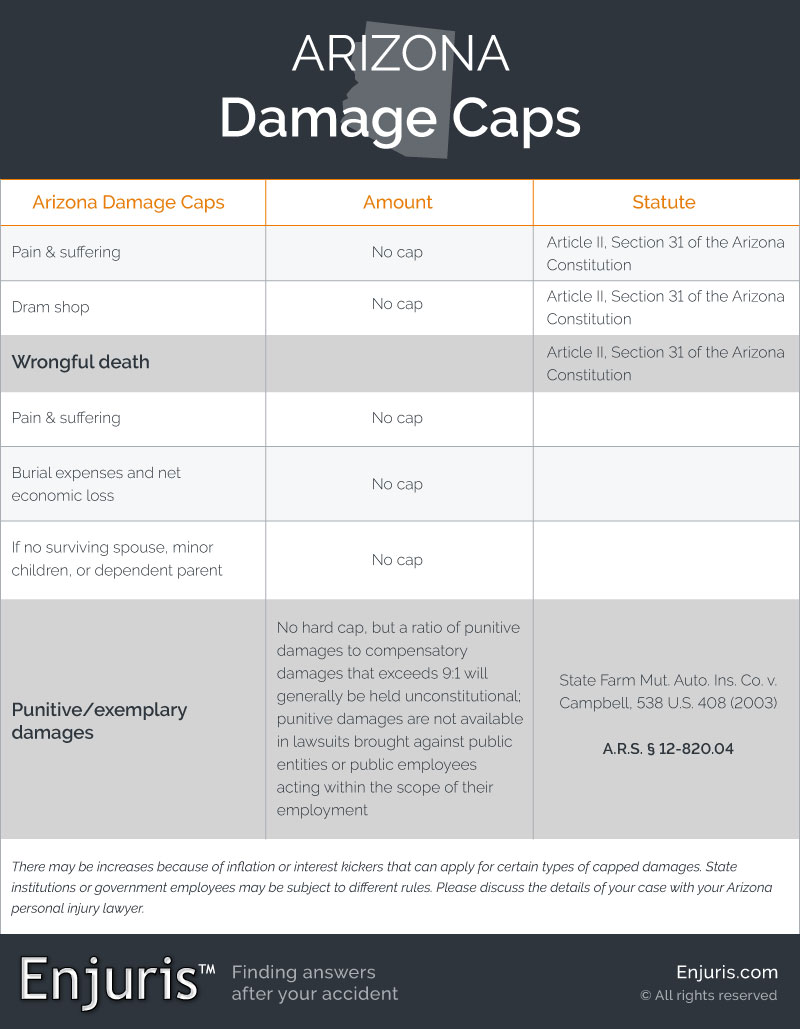
Does the Grand Canyon State place limits on personal injury settlements and judgments?
A “damage cap” is a law that limits the amount of compensation an injured person can receive in a lawsuit. A number of states have established damage caps for certain types of cases and categories of damages.
Arizona is 1 of only 5 states whose Constitution prohibits capping damages for personal injury lawsuits.
Let’s take a closer look at damage caps and their role in Arizona personal injury cases.
Types of damages
In a personal injury case, you’re entitled to compensation from the person or entity responsible for your injuries. The term for this compensation is “damages.” In Arizona, there are three main categories of damages:
- Economic damages
- Non-economic damages
- Punitive damages
In states with damage caps, the cap often applies to a specific category of damages. For example, a state might cap non-economic damages at $500,000, but not place a cap on economic damages. Or a state might place a $500,000 cap on both economic and non-economic damages, but prohibit a plaintiff from recovering any punitive damages at all.
Let’s take a closer look at each category of damages.
Economic
Economic damages (sometimes called “special compensatory damages”) are designed to compensate you for the monetary losses caused by your injury. These losses might include:
- Medical expenses
- Lost income
Non-economic
Non-economic damages (sometimes called “general compensatory damages”) are designed to compensate you for the non-monetary consequences of you injury. These damages are difficult to prove and might include:
- Physical pain and suffering
- Emotional distress
- Loss of consortium
Punitive
Punitive damages are intended to punish a defendant for their conduct and to deter others from engaging in similar conduct. In Arizona, punitive damages are only available in two types of cases:
- Cases where the defendant had ill will and intentionally caused harm to the victim
- Cases where the defendant knew what they were doing was unsafe and likely to cause harm
Arizona doesn’t recognize a cap on punitive damages against private individuals or companies. However, the United States Supreme Court in State Farm Mut. Automobile Ins. Co. v. Campbell, 538 U.S. 408 (2003) ruled that a ratio of punitive damages to compensatory damages that exceeds 9:1 will generally be deemed unconstitutional.
Arizona completely prohibits punitive damages in personal injury actions against public entities or public employees acting within the scope of their employment.
Arizona Damage Caps

Damage caps are prohibited by Arizona’s Constitution
The Constitution of the State of Arizona prohibits placing caps on damages for personal injury or death.
Specifically, Article 2, Section 31 of the Constitution states that:
“No law shall be enacted in this state limiting the amount of damages to be recovered for causing the death or injury of any person.”
This means that in Arizona the jury has complete authority to decide the amount of damages awarded in a personal injury lawsuit. A judge won’t reduce the jury’s award unless the award is so excessive or inconsequential that it’s considered unjust.
The Constitutions of Arkansas, Kentucky, Pennsylvania, and Wyoming also include language specifically prohibiting the limitation of damage awards in tort cases.
Challenges to Arizona’s Constitution
Because the Arizona Constitution prohibits lawmakers from limiting the amount of damages recoverable in a personal injury lawsuit, instituting damage caps would require amending the Constitution. In Arizona, the amendment process involves two steps:
- The initiation of an amendment by either a majority vote of both houses in the legislature, a convention called by the people and the legislature by a majority vote, or a petition signed by a number equal to at least 15% of the votes cast for the office of governor in the last general election
- A majority vote in a general or special election
On three occasions (in 1986, 1990, and 1994), voters in Arizona were given the opportunity to amend the Constitution to allow for damage caps. On each occasion, a majority of voters rejected the proposed amendment.
There have been recent talks about initiating yet another amendment to allow for damage caps.
Workers’ compensation claims
Workers’ compensation claims are different than civil lawsuits. Arizona’s prohibition of damage caps applies to civil lawsuits, not workers’ compensation claims.
In a workers’ compensation claim, an injured employee is entitled to lifetime medical and compensation benefits, but the total compensation that can be awarded is capped by law.
Comparative fault
Arizona follows a “pure comparative fault theory.” This means that the amount of damages a plaintiff can recover in a personal injury suit is reduced by a percentage that reflects the plaintiff’s degree of fault—no matter what that percentage may be.
For example, let’s say a driver runs a red light and crashes into you. But let’s also say you were driving at night with your headlights off. At trial, the jury finds you 20% at fault and the defendant 80% at fault. Under Arizona’s comparative fault theory, you would only be able to recover 80% of your damages.
While this isn’t technically a “damage cap,” it does represent a potential limitation to the amount of damages you can recover in a personal injury lawsuit.
If you have questions about what sort of compensation might be available in your personal injury case, use our free online directory to contact an experienced Arizona attorney.
See our guide Choosing a personal injury attorney.
